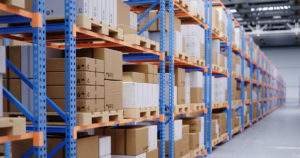Common Warehouse Injuries
October 30, 2020 The Bureau of Labor Statistics (BLS) estimates that there are over 1.1 million warehouse workers in the U.S., but with the industry growing at rapid rates, more and more people are taking jobs as warehouse workers every year. Warehouse jobs can be quite dangerous. Employees face an array of jobsite hazards, such as overexertion injuries, trips, slips, and falls, loading dock injuries, forklift accidents and more. Due to the dangerous nature of the job, it is vital that employers take the necessary steps to protect workers from preventable accidents and injuries.
The Bureau of Labor Statistics (BLS) estimates that there are over 1.1 million warehouse workers in the U.S., but with the industry growing at rapid rates, more and more people are taking jobs as warehouse workers every year. Warehouse jobs can be quite dangerous. Employees face an array of jobsite hazards, such as overexertion injuries, trips, slips, and falls, loading dock injuries, forklift accidents and more. Due to the dangerous nature of the job, it is vital that employers take the necessary steps to protect workers from preventable accidents and injuries.
Companies like Amazon, UPS, FedEx, and Walmart – just to name a few – employ hundreds of thousands of warehouse workers. For example, more than $50 million has been spent breaking ground on new industrial complexes along Pennsylvania’s I-78 corridor, PA Turnpike, and near other major roadways.
Warehouse Dangers
Warehouse workers perform a variety of tasks related to receiving and processing goods and materials, like packaging and managing orders, shipping items, retrieving goods, and organizing inventory. Warehouse employees may also work on or around heavy industrial equipment like toggle machines, conveyor belts, forklifts, label machines, and sorting devices. According to the Occupational Safety and Health Administration (OSHA), the most common hazards that warehouse workers come into contact with are:
- Poor ergonomics. Repetitive motions, improper lifting and subpar operation design can cause musculoskeletal disorders, or MSDs, in workers. Musculoskeletal disorders can cause long-term or permanent disabilities
- Improper lockout/tagout procedures of industrial equipment. Lockout/tagout devices safeguard workers from the unexpected startup of machinery, which can release hazardous energy and cause catastrophic consequences
- Conveyor belts. Body parts can catch in pinch points or by in-going nip points, leading to serious injuries like amputations. Workers also face risks of being hit by falling materials
- Forklift accidents. Nearly 100,000 employees are injured and another 100 die in forklift accidents every year. Forklift rollovers, also known as turnovers, account for the majority of these deadly accidents
- Dock and dock plate accidents. Unsecured dock plates and unmarked dock edges both contribute to preventable warehouse injuries
- Improperly stored materials
- Chemical burns resulting from hazardous materials spills
As you can see, warehouse workers face serious job-related dangers every day. Not only are employers are legally responsible for addressing known hazards but also for implementing effective solutions that mitigate them. OSHA has several safety and health protocols in place that warehouse employers must follow for this very reason.
Injured at Work?
Most nonfatal and fatal warehouse accidents are preventable. Sadly, the fatal injury rate in the warehouse industry remains higher than in other industries, proving just how critical it is for employers to do a better job at protecting workers. Warehouse employers are most frequently cited for safety failures involving forklifts, floors, wall openings, and holes, respiratory protection, lockout/tagout procedures, fire protection programs, and electrical system designs and wiring.
Put simply, employers are responsible for providing workers with safe workplaces. Employers have several key responsibilities to ensure this, including compliance with federal safety standards, providing safety training in a language workers can understand, keeping comprehensive reports of work-related illnesses and injuries, writing hazard communication programs, and conducting routine jobsite inspections.
In some cases, a third party is responsible for an individual’s injuries. Though all manufacturers of industrial equipment have the duty to create safe products, they sometimes fail to fulfill their obligation in favor of greater financial profits. When a machine injures a worker because of a design flaw, lack of safety features, or insufficient guarding, it is time to consider filing a products liability claim. In other cases, workers are injured because an outside machine maintenance contractor failed to adequately inspect and maintain jobsite equipment, therefore endangering employees. Determining which party or parties are at fault in a serious workplace accident is a complex process, but someone at our firm can help. To learn more about filing a claim, contact a representative online now.
Philadelphia Workers’ Compensation Lawyers at Galfand Berger, LLP Representing Injured Workers Since 1947
Galfand Berger has offices located in Philadelphia, Bethlehem, Lancaster, and Reading, we serve clients throughout Pennsylvania and New Jersey. To schedule a consultation, call us at 800-222-8792 or complete our online contact form.
 Google Screened
Google Screened
